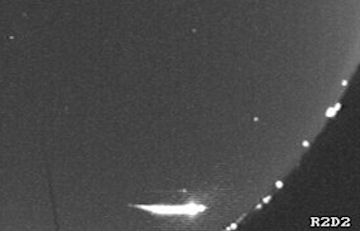NEW AND IMPROVED: Turn your iPhone or iPod Touch into a field-tested global satellite tracker. The Satellite Flybys app now works in all countries. | | | TURN OFF THE LIGHTS: On Saturday, March 27th, hundreds of millions of people around the world will switch off their lights for Earth Hour. It's a great way to save energy and see the night sky. No matter where you live, the event begins at 8:30 pm local time. SUNSPOT CONJUNCTION: On Thursday in Cape Elizabeth, Maine, astrophotographer John Stetson and his son Peter observed a very rare event--a sunspot-space station conjunction: 
Photo details: 5-inch AP refractor, Baader solar filter, Luminera 2-0 camera
"We knew when to look thanks to a prediction from CalSky," says Stetson. "The International Space Station transited the solar disk in only 0.62 seconds. We managed to catch the station's silhouette just as it was passing sunspot 1057." Stetson has been photographing solar transits for years; he ranks this one as "the best yet." As far as we know, this is the first time the ISS has been observed in conjunction with a big sunspot. Next up: How about a sunspot-space station eclipse? It is possible to anticipate such an event because CalSky shows sunspots in their transit prediction graphics. Astrophotographers, check the web site for opportunities. more images: from Rogerio Marcon of Campinas-SP-Brasil; from Wouter Verhesen of Sittard. The Netherlands; from Alcaria Rego of Almada, Portugal; from Andy Devey of Barnsley, South Yorkshire, UK; from John C McConnell of Maghaberry Northern Ireland; from Gianfranco Meregalli of Milano Italy; from Monika Landy-Gyebnar of Veszprem, Hungary; LOW-FLYING METEOR: On March 19th at 11:19 Central Time, a meteoroid entered Earth's atmosphere over the southeastern United States and disintegrated in a flash as bright as the crescent Moon. To the human eye, it appeared to be a garden-variety fireball, the kind that appears almost every clear night, but NASA cameras had a different story to tell. Scroll past the fireball snapshot for details. 
"This was an unusually low-flying meteor," says Bill Cooke of NASA's Meteoroid Environment Office. Cooke and colleagues operate a pair of all-sky cameras, one in Huntsville, Alabama, and another in Chickamauga, Georgia. Both cameras caught the fireball, allowing rapid triangulation of its flight path. "It was first recorded at an altitude of 72.9 km (45.3 miles) and burned up at an altitude of 32.5 km (20.2 miles)." That's low. Most meteoroids disintegrate around 70 to 80 km high. This one held together for a much deeper descent. "It had a lot of structural integrity. Maybe it was a metallic object," speculates Cooke. "Based on the brightness and velocity of the fireball, I estimate a mass of about 10 kilograms and a diameter of ~20 centimeters - a decent size!" Cooke's meteor mini-network is "smart." When both cameras catch a fireball, the system's software springs into action and immediately calculates a flight path and orbit for the meteoroid. Cooke receives an email alerting him to intteresting events that might otherwise have gone unnoticed. "In the near future, we plan to expand our network along the eastern seaboard of the United States," notes Cooke. "With smart cameras on duty, who knows what we might find?" Stay tuned for the unexpected.
March Northern Lights Gallery
[previous Marches: 2009, 2008, 2007, 2006, 2005, 2004, 2003] | 
